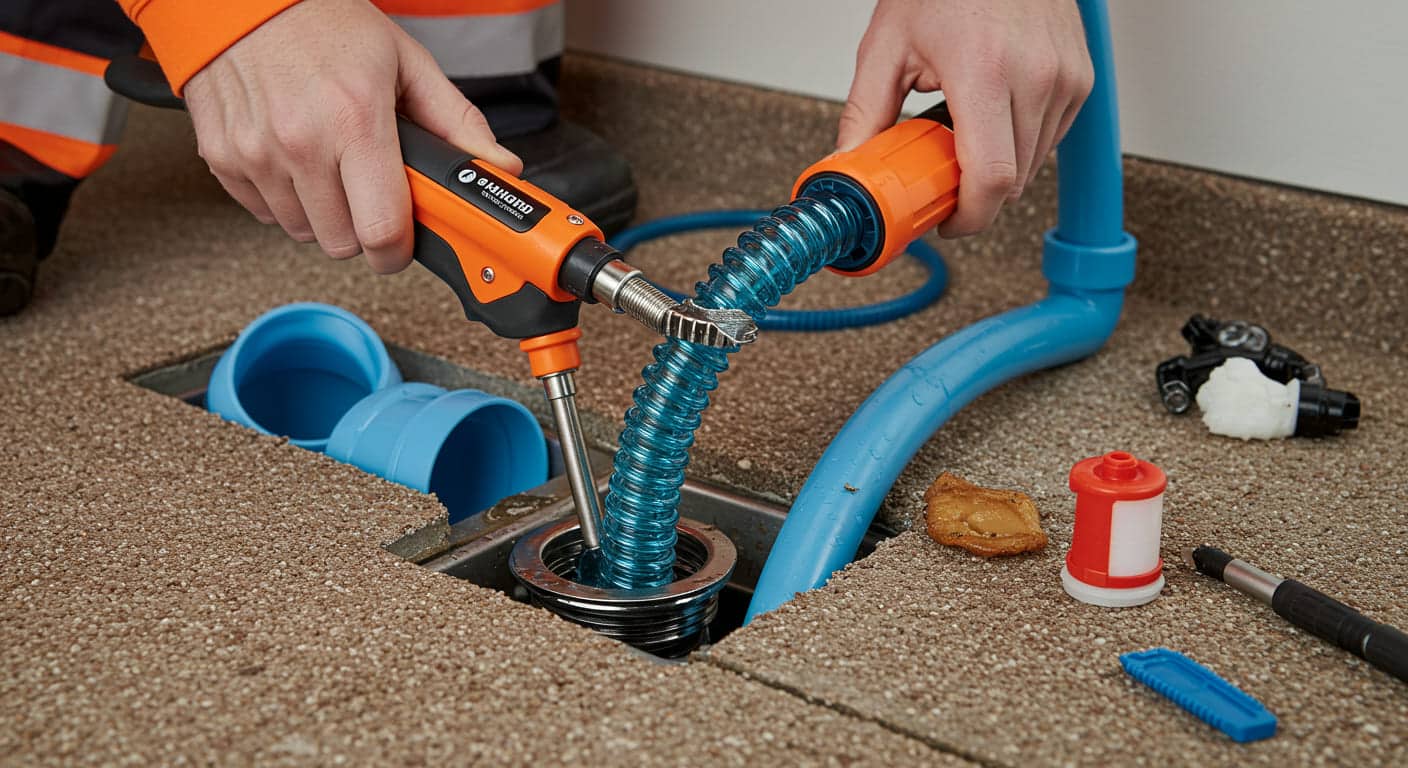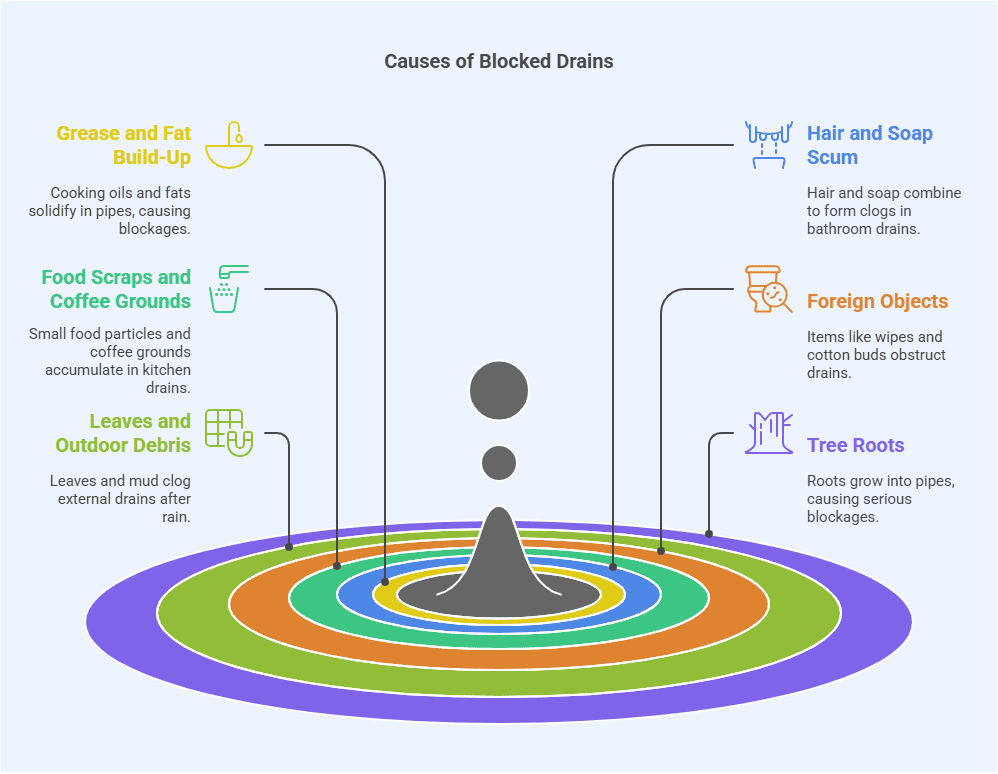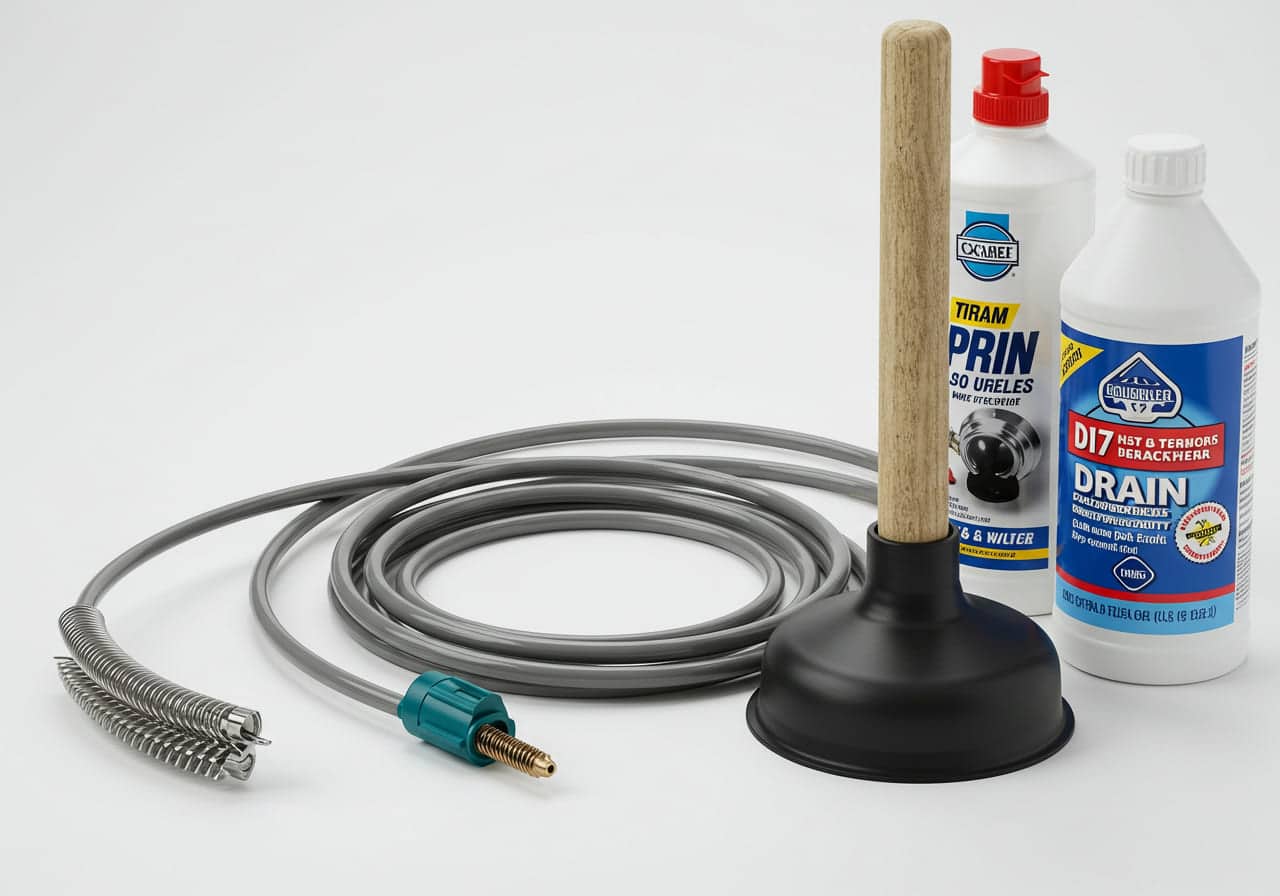
Why Drains Get Blocked
A blocked drain can turn into a real headache, whether it’s water pooling around the sink or unpleasant odours wafting through your home. It’s a problem that happens to the best of us, but the good news is that many drain blockages can be tackled with simple DIY methods.
Drains often get blocked when everyday materials like grease, soap, food scraps, and hair build up within the pipe. Over time, this build-up restricts the flow of water down the drain, leading to slow-draining sinks or baths. In some cases, foreign objects washed down the sink or external factors like tree roots can also obstruct your drainage system.
This guide is here to help you understand the common causes of blocked drains and provide you with effective, easy-to-follow tips to unblock your drain yourself. We’ll walk you through several methods, from using boiling water to the tried-and-true baking soda and vinegar solution.
Ready to tackle your blocked drain? Let’s dive in!
Warning Signs of a Blocked Drain
Blocked drains don’t happen overnight, they usually start with a few subtle warning signs. Recognising these early can help you address the issue before it becomes a bigger problem.
Here are the most common signs that your drain is blocked:
- Slow Draining Water
If water takes longer than usual to disappear down the sink, shower, or bath, it’s often a sign of a blockage forming within the pipe. You might also notice water pooling around the drain after use. - Unpleasant Smells
Foul smells coming from your plughole or drains are a common sign of build-up. This could be food scraps, grease, or soap scum decomposing within the drainage system. - Gurgling Sounds
Strange noises like gurgling or bubbling are caused by trapped air in the pipes. This often indicates that water isn’t flowing freely due to a blockage. - Water Backing Up
In more severe cases, water might flow back up through the sink, bath, or shower instead of draining away. This usually means the drain is blocked completely and needs immediate attention.
What Happens If You Ignore the Signs?
Delaying action can turn a small blockage into a major drainage issue. Water can start overflowing, causing potential damage to your home, while odours and bacteria from the clogged drain can pose health risks. If you’re noticing these warning signs, waste no time pouring over potential fixes. Keep reading for simple ways to unblock your drain.
Common Causes of Blocked Drains
Understanding the root cause of a blocked drain is the first step to finding the right solution. Drains can become clogged for many reasons, some of which might surprise you. Here are the most common culprits:
- Grease and Fat Build-Up
Cooking oils, grease and fat often get washed down the sink, where they cool and solidify within the pipes. Over time, this creates a sticky coating that traps other debris, leading to a drain blockage. - Hair and Soap Scum
In bathrooms, hair and soap scum are two of the most common causes of blockages. Hair tangles and combines with soap residue to create clogs within the drain pipe, especially in baths and showers. - Food Scraps and Coffee Grounds
Even small food particles washed down the sink can build up over time. Coffee grounds are particularly troublesome, as they don’t dissolve and often sit within the pipe, adding to existing blockages. - Foreign Objects
Items like wipes, cotton buds, or jewellery flushed down the toilet or sink can cause significant blockages, as they aren’t designed to break down in the drainage system. - Leaves and Outdoor Debris
External drains are prone to blockages caused by leaves, mud, and other debris, especially after heavy rain. These can clog the drainage pipe, causing water to back up around the drain. - Tree Roots
Tree roots are a more serious issue, as they can grow into underground pipes, cracking or blocking them. If external drains are frequently clogged, tree roots might be the underlying cause.
How to Prevent These Issues
To minimise the risk of a clogged drain:
- Avoid pouring grease or oil down the drain.
- Use a strainer to catch food scraps and hair.
- Regularly clean your plughole to prevent build-up.
- For outdoor drains, clear debris around the drain cover after storms.
Effective DIY Methods to Unblock Your Drain
If your drain is blocked, you don’t always need to reach for harsh chemicals or call a plumber immediately. There are several tried-and-true DIY methods to tackle the most common blockages. Here are the best ways to unblock your drain safely and effectively:
1. Boiling Water Method
- What You’ll Need: A kettle filled with boiling water.
- How to Do It:
- Boil a kettle with as much water as possible.
- Pour boiling water slowly down the drain in two to three stages, allowing the heat to break down grease or grime within the pipe.
- Repeat the process if necessary.
- Why It Works: Grease and soap scum dissolve under high temperatures, making this a quick and easy fix for minor clogs.
2. Baking Soda and Vinegar Method
- What You’ll Need: Half a cup of baking soda, one cup of vinegar, and boiling water.
- How to Do It:
- Pour half a cup of baking soda down the plughole.
- Follow with a cup of vinegar. You’ll notice a fizzy reaction, this is the solution working to dislodge grime and debris.
- Let the mixture sit for an hour.
- Finish by pouring boiling water down the drain to flush away loosened debris.
- Why It Works: The chemical reaction between baking soda and vinegar helps break down stubborn build-ups, making it ideal for greasy or grimy clogs.
3. Plunger Method
- What You’ll Need: A standard sink or toilet plunger and some water.
- How to Do It:
- Ensure there’s enough water in the sink or bath to create a seal around the plunger.
- Place the plunger over the drain and press firmly to create suction.
- Use rapid, consistent motions to dislodge the blockage.
- Check to see if the water drains freely.
- Why It Works: The plunger’s suction helps move and loosen stubborn blockages deep in the drainage pipe.
4. Wire Coat Hanger Method
- What You’ll Need: A wire coat hanger, rubber gloves, and patience.
- How to Do It:
- Straighten a wire coat hanger and bend one end into a small hook.
- Remove the drain cover and start fishing for debris.
- Carefully pull out any hair or gunk you can reach.
- Flush with hot water to clear away remaining debris.
- Why It Works: This method is excellent for removing physical debris like hair and soap scum that often collects around the drain.
5. Soda Crystals and Hot Water
- What You’ll Need: Soda crystals and boiling water.
- How to Do It:
- Pour a generous amount of soda crystals down the drain.
- Follow with boiling water to activate the crystals and dissolve grease or grime.
- Run the hot water for a minute to flush everything out.
- Why It Works: Soda crystals are a powerful yet eco-friendly option for clearing grease and soap scum blockages.
When DIY Doesn’t Work
If none of these methods seem to unblock your drain, or the blockage keeps coming back, it’s time to call in professional help. London Drains Direct can diagnose and resolve even the most stubborn drainage problems quickly and effectively.
Why You May Need Professional Help
Sometimes, no matter how hard you try, a blocked drain refuses to budge. Stubborn blockages or recurring issues often point to more serious problems within your drainage system. Here are the key signs that it’s time to call in the experts:
1. Recurring Blockages
If you find yourself dealing with a clogged drain repeatedly, it could mean a deeper issue, such as build-up further within the pipe. DIY methods may temporarily relieve the symptoms but not address the root cause.
2. Foul Smells That Won’t Go Away
If foul smells persist despite your efforts to unblock the drain, it’s likely that grease, food, or other waste has built up in hard-to-reach areas of your pipes. Professional drainage tools are often necessary to clear this kind of blockage completely.
3. Water Backing Up or Overflowing
When water comes back up through your sink, bath, or shower, it’s a clear sign that the drain is blocked completely. This may require specialised equipment, such as drain rods or high-pressure jetting, to clear the obstruction.
4. Slow Draining Despite DIY Fixes
If water continues to drain slowly even after you’ve tried boiling water, baking soda and vinegar, or other DIY methods, the issue may be too far down the line for home remedies to work.
5. Suspected Structural Issues
Blocked drains caused by tree roots, pipe damage, or collapsed drainage systems can only be resolved with professional expertise. These problems require advanced tools, such as cameras to inspect the pipes and tailored repair solutions.
Why Choose London Drains Direct?
If you’ve tried everything and your drain is still causing problems, it’s time to seek professional help. London Drains Direct offers:
- Rapid Response Times: Perfect for urgent situations like overflowing drains.
- Expert Diagnosis: From identifying drainage pipe issues to tackling severely blocked drains.
- Advanced Tools: Professional-grade drain snakes, jetting equipment, and cameras to locate and resolve blockages quickly.
- Transparent Service: We’ll explain the problem clearly and offer the best solution without hidden costs.
When It’s Time to Act
Ignoring a blocked drain can lead to serious issues like water damage or even health hazards. Don’t wait until it’s too late contact London Drains Direct today for a fast, reliable service. Give us a call, and let us take care of your drainage problem.



